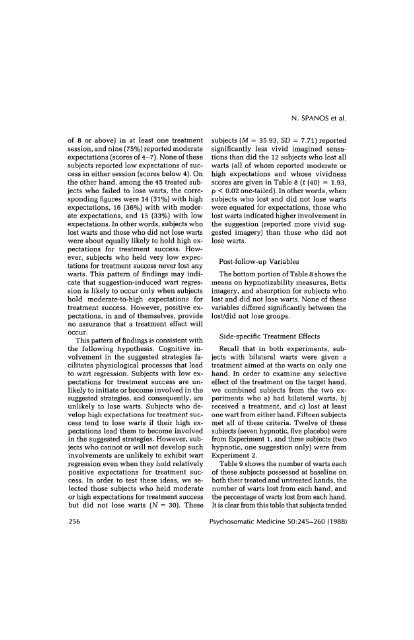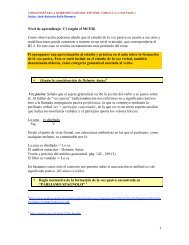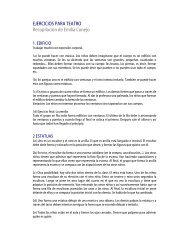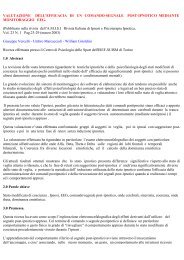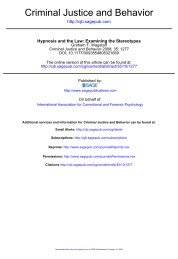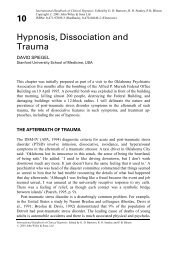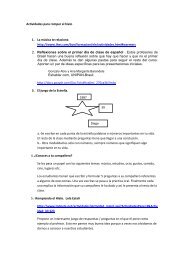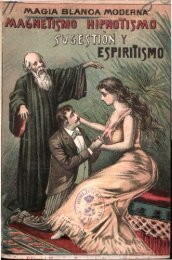Hypnosis, Placebo, and Suggestion in the Treatment of Warts
Hypnosis, Placebo, and Suggestion in the Treatment of Warts
Hypnosis, Placebo, and Suggestion in the Treatment of Warts
You also want an ePaper? Increase the reach of your titles
YUMPU automatically turns print PDFs into web optimized ePapers that Google loves.
N. SPANOS et al.<strong>of</strong> 8 or above) <strong>in</strong> at least one treatmentsession, <strong>and</strong> n<strong>in</strong>e (75%) reported moderateexpectations (scores <strong>of</strong> 4-7). None <strong>of</strong> <strong>the</strong>sesubjects reported low expectations <strong>of</strong> success<strong>in</strong> ei<strong>the</strong>r session (scores below 4). On<strong>the</strong> o<strong>the</strong>r h<strong>and</strong>, among <strong>the</strong> 45 treated subjectswho failed to lose warts, <strong>the</strong> correspond<strong>in</strong>gfigures were 14 (31%) with highexpectations, 16 (36%) with with moderateexpectations, <strong>and</strong> 15 (33%) with lowexpectations. In o<strong>the</strong>r words, subjects wholost warts <strong>and</strong> those who did not lose wartswere about equally likely to hold high expectationsfor treatment success. However,subjects who held very low expectationsfor treatment success never lost anywarts. This pattern <strong>of</strong> f<strong>in</strong>d<strong>in</strong>gs may <strong>in</strong>dicatethat suggestion-<strong>in</strong>duced wart regressionis likely to occur only when subjectshold moderate-to-high expectations fortreatment success. However, positive expectations,<strong>in</strong> <strong>and</strong> <strong>of</strong> <strong>the</strong>mselves, provideno assurance that a treatment effect willoccur.This pattern <strong>of</strong> f<strong>in</strong>d<strong>in</strong>gs is consistent with<strong>the</strong> follow<strong>in</strong>g hypo<strong>the</strong>sis. Cognitive <strong>in</strong>volvement<strong>in</strong> <strong>the</strong> suggested strategies facilitatesphysiological processes that leadto wart regression. Subjects with low expectationsfor treatment success are unlikelyto <strong>in</strong>itiate or become <strong>in</strong>volved <strong>in</strong> <strong>the</strong>suggested strategies, <strong>and</strong> consequently, areunlikely to lose warts. Subjects who develophigh expectations for treatment successtend to lose warts if <strong>the</strong>ir high expectationslead <strong>the</strong>m to become <strong>in</strong>volved<strong>in</strong> <strong>the</strong> suggested strategies. However, subjectswho cannot or will not develop such<strong>in</strong>volvements are unlikely to exhibit wartregression even when <strong>the</strong>y hold relativelypositive expectations for treatment success.In order to test <strong>the</strong>se ideas, we selectedthose subjects who held moderateor high expectations for treatment successbut did not lose warts (N = 30). Thesesubjects (M = 35.93, SD = 7.71) reportedsignificantly less vivid imag<strong>in</strong>ed sensationsthan did <strong>the</strong> 12 subjects who lost allwarts (all <strong>of</strong> whom reported moderate orhigh expectations <strong>and</strong> whose vividnessscores are given <strong>in</strong> Table 8 (t (40) = 1.93,p < 0.02 one-tailed). In o<strong>the</strong>r words, whensubjects who lost <strong>and</strong> did not lose wartswere equated for expectations, those wholost warts <strong>in</strong>dicated higher <strong>in</strong>volvement <strong>in</strong><strong>the</strong> suggestion (reported more vivid suggestedimagery) than those who did notlose warts.Post-follow-up VariablesThe bottom portion <strong>of</strong> Table 8 shows <strong>the</strong>means on hypnotizability measures, Bettsimagery, <strong>and</strong> absorption for subjects wholost <strong>and</strong> did not lose warts. None <strong>of</strong> <strong>the</strong>sevariables differed significantly between <strong>the</strong>lost/did not lose groups.Side-specific <strong>Treatment</strong> EffectsRecall that <strong>in</strong> both experiments, subjectswith bilateral warts were given atreatment aimed at <strong>the</strong> warts on only oneh<strong>and</strong>. In order to exam<strong>in</strong>e any selectiveeffect <strong>of</strong> <strong>the</strong> treatment on <strong>the</strong> target h<strong>and</strong>,we comb<strong>in</strong>ed subjects from <strong>the</strong> two experimentswho a) had bilateral warts, b)received a treatment, <strong>and</strong> c) lost at leastone wart from ei<strong>the</strong>r h<strong>and</strong>. Fifteen subjectsmet all <strong>of</strong> <strong>the</strong>se criteria. Twelve <strong>of</strong> <strong>the</strong>sesubjects (seven hypnotic, five placebo) werefrom Experiment 1, <strong>and</strong> three subjects (twohypnotic, one suggestion only) were fromExperiment 2.Table 9 shows <strong>the</strong> number <strong>of</strong> warts each<strong>of</strong> <strong>the</strong>se subjects possessed at basel<strong>in</strong>e onboth <strong>the</strong>ir treated <strong>and</strong> untreated h<strong>and</strong>s, <strong>the</strong>number <strong>of</strong> warts lost from each h<strong>and</strong>, <strong>and</strong><strong>the</strong> percentage <strong>of</strong> warts lost from each h<strong>and</strong>.It is clear from this table that subjects tended256 Psychosomatic Medic<strong>in</strong>e 50:245-260 (1988)


